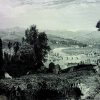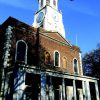James Pennington is one of the lesser-known figures after whom a street has been named in Adelaide. His inclusion was determined by the fact that he was a member of the South Australian Colonization Commission. His name is held in perpetuity in the leafy precinct known as Pennington Terrace, which overlooks both Adelaide Oval and the Soldiers Memorial Gardens.
The Street Naming Committee decision to include Pennington was automatic; some might say perfunctory. That is to say, merely because he was a commissioner and perhaps not because of who he was. Both he and Josiah Roberts had been latter-day substitutes on the Commission, a change necessitated because two of the original members were found to have a financial conflict of interest. Both Roberts and Pennington were invited to join the South Australian Commission well into the process and not long before the first ships were to sail for South Australia. Pennington joined in January 1836 on the recommendation of the Chairman, Colonel Robert Torrens, a fellow member and friend from the Political Economy Club. He had come to notice after Roberts joined on Tuesday 2 February on the recommendation of George Fife Angas.
James Pennington was born on 23 February 1777 in what was then the idyllic village of Kendal, Westmorland. He was the third of five children born to William Pennington and his wife, Agnes (nee Wilson), who both came from Quaker stock in the vicinity. The Pennington name had long been associated with this part of England and there were many branches of the family dating back to before the conquest of 1066. Perhaps the earliest reference is to Gamel de Pennington, whose ancient house was seated in Penitone, Lancashire. A direct descendant of this line, Sir John de Pennington later gave coverage and protection to King Henry VI of the House of Lancaster as he fled the armies of the House of York. This Pennington family line has understandably enjoyed royal patronage.
In 1783 Sir John Pennington was created Baron Muncaster. The hereditary line continues to this day. James Pennington’s family heritage is not quite as glamorous but is nevertheless significant. R.S. Sayers believes that the family line probably stemmed from a highly regarded Mayor of London by the name of Pennington, who held the keys to the city between 1642 and 1644. This line joined the Society of Friends sometime in the eighteenth century and migrated northwards, where they settled in and around Kendal.
James’ father, William, like his grandfather, remained in Kendal into adult life where he became a versatile member of the community. In addition to owning a bookshop in the village, he was a printer and an architect. In later years he rose to become the Mayor. James’ mother, Agnes, was the daughter of a clockmaker.
Our subject, James Pennington, who was later to join Britain’s most exclusive coterie of political economists as a member of the distinguished Political Economy Club, began his schooling almost contemporaneously with those he would later join there. He was enrolled in the Quaker school in Kendal where his numerical prowess developed to become exceptional, attributed in large measure to two teachers who influenced the young Pennington to the extent he was later thought to have a mind akin to an elementary computer.
On completion of his schooling James Pennington moved to London. There he was variously employed in business as a merchant and an accountant, although little is known of his activities during this period. By 1803 he was registered as a subscriber to Lloyd’s, and in 1807–08, while at a Fenchurch Street, London address, he appears on the registry of subscribers to the Royal Scottish Corporation, a Scottish hospital in London founded by Charles II.
On 30 November 1811 he married Mary Anne Harris of Clapham, a newly emerging suburb of South London where he and Anne settled down to raise their family. They were for a time near neighbours of the distinguished essayist Thomas Babington Macaulay and his family. James and Mary had four sons and three daughters, all of whom became devout parishioners of the Clapham Anglican Parish, the seat of the now famous Clapham Sect. James and Mary worshipped in Clapham for the rest of their days.
In 1828, after visiting the Political Economy Club several times as a guest, James Pennington was eventually admitted to the exclusive membership. To be proposed by Tooke, one of the founders who had a particular penchant for economic statistics, flattered Pennington, his heart swelling with pride. Inaugurated in 1821 by Colonel Torrens, Ricardo, James Mill and Thomas Malthus – all noted political economists – the Club had a capped membership of only thirty-five. Coming after Adam Smith and The Wealth of nations as it did, it was essentially the first professional academic association for economists in Britain and focused entirely on the new science of the day known as political economy.
Pennington’s abilities had become known to the membership by the mid-1820s and he was invited to join. His mathematical abilities, especially with regard to currency matters, had by this time become legendary. He remained a member of the Political Economy Club from February 1828 to July 1856, when presumably his health was failing.
Throughout the 1830s and 1840s Pennington contributed strongly to the seminar program of the Political Economy Club, which included presentation of between one and four major seminar questions each year. This allowed members to lead a discussion on topics that all had economic implications for governments and nations. Questions included issues to do with monetary policy, currency, bullion, trade, tariffs, corn, taxes, prices, labour, colonisation and the macroeconomic questions of distribution and liability.
Pennington’s theoretical appreciation of economic principles and how they might be applied in government and commerce came under notice as early as 1826. Tom Humphrey says in that year Pennington submitted ‘three path-breaking memoranda on the creation and control of the money stock to William Huskisson, the President of the Board of Trade’.
Humphrey and Sayers are the only two writers thus far who have studied James Pennington in any depth and they were both perplexed as to how he might have found the ear of Huskisson and other government ministers. They both presume that he was an outsider in the political circles of the day. There appears to be no evidence to support this view. Sayers argues that it was Tooke who provided the leverage for Pennington to curry favour, and while this may be true with respect to his membership of the Political Economy Club, once a member, patronage was readily to hand, especially for one with so much to offer. However, given the circles Pennington was moving in it is not so surprising. Simply by association he was bound to be influential, despite any inhibiting eccentricities which he might have displayed.
The momentous electoral changes in Britain following the Reform Bill of 1832 could not have come at a better time for Pennington. With so many new politicians in the House and the old traditional lines of partisanship overturned, the call for radical change grew louder. British colonial expansion had generated great wealth for some and oppression for others. There was a thriving, if somewhat exploitative, international marketplace and the call for free trade from the ranks of the political economists rang through the halls of Westminster. Those who sat with the majority of dissenters in the House seized their opportunities. Slavery was abolished in all British colonies and territories (in 1833), and the wings of the East India Company were clipped (Charter Act 1833) as liberal sentiment sought to redress past injustices and inequities. Both of these developments had powerful financial and economic effects on Treasury. The government of the day had turned to Pennington for help.
In 1832 Pennington was appointed by Charles Grant, a fellow parishioner at Holy Trinity and President of the India Board of Trade, as a consultant to audit the books of the East India Company preparatory to the winding down of trading business of that company. This was the first of a series of consultancies to various arms of government to which he was appointed over the next decade or so, and he continued to submit memoranda on various aspects of monetary policy and banking with special reference to currency, coinage and bullion.
This contract held the promise of being sufficiently lucrative to enable Pennington to abandon whatever else he was doing to support his family and to seek other opportunities in government. Thenceforth, he declared himself to be James Pennington, political economist. Several additional opportunities arose. The abolition of slavery in 1833 was not cost-neutral. Twenty million pounds was paid in reparation to the slave owners on the condition they then re-employ some of their workforce as apprentices. With such large amounts of money flowing between Britain and her dependencies, the stability of the currencies, especially in the West Indies, was at risk. Pennington was immediately called in to address this question.
Such is the nature of contractual arrangements for consultants that on a change of government in 1834, probably when the Tory government was briefly restored, Pennington’s contract lapsed and he was let go. His consultancy had been quite a lucrative one of £1,500 a year. He was devastated and the £500 in compensation he extracted from a later government hardly made up for the loss. He spent the next ten years seeking redress on this issue, and although Robert Peel later consulted him closely on the Bank Charter Act 1844, he never did achieve full recompense.
For the next ten years or so he was engaged in a number of minor assignments, which were presumable enough to support his family. In the mid-1840s he wrote The currency of the British Colonies, which was originally published anonymously in London by Clowes and Sons in 1848. Apparently it was written for official use. This was later reprinted (in 1967) in New York and is now one of the economic classics studied by scholars researching the history of economic thought.
It should be said that if it weren’t for Colonel Torrens, James Pennington would not be memorialised in the streets of Adelaide. Torrens obviously thought he owed something to Pennington because in his book Colonization of South Australia, first published in 1835, he acknowledges rather modestly that he had ‘done little more than follow the principles of Senior, Chalmers, Pennington, Scrope, Longfield and Wakefield’.
James Pennington died at his home at 8 Northside on Clapham Common, on 23 March 1862. He was never a man of any great wealth and his estate was valued at a mere £3,000. He is not to be confused with G.J. Pennington, who was Pro Secretary to James Stephen and a member of the Reform Club.







Comments